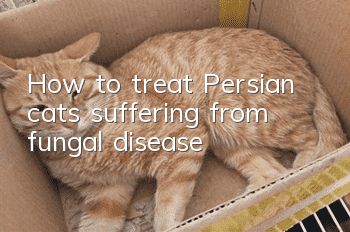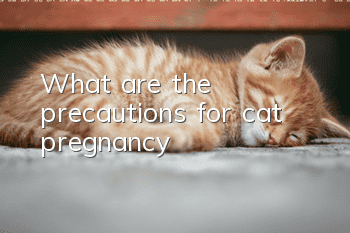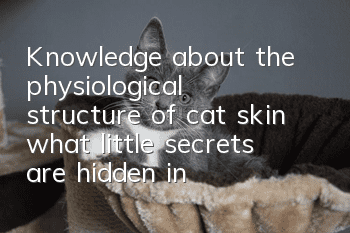How to treat Persian cats suffering from fungal disease?

How to treat Persian cats with mycosis? Persian cats are one type of long-haired cats, and skin mycosis is a common skin disease that Persian cats are prone to and prone to relapse. So how to treat if they get the disease? Woolen cloth?
1. The pathogenesis of skin mycosis in Persian cats
More than 90% of Persian cats’ skin mycosis is caused by Caninum spores. Caninum spores is a disease that can be infected in dogs, Persian cats and humans, that is, Commonly known as ringworm, dermatologists believe it is an allergic dermatitis caused by cat hair, causing many owners to give up their Persian cats. However, in fact, it may be caused by dogs or even other sick people. It's contagious.
2. Symptoms of skin mycosis in Persian cats
Persian cat skin mycosis, if severe, may spread to the whole body. Affected Persian cats usually have circular areas of hair loss, and most of them have scales. Apart from hair loss, there may be nothing unusual about the affected area, and hair loss may occur in any part of the body; however, kittens are particularly infectious. If the mother cat has suffered from skin mycosis, the kitten will urinate during the suckling process. May cause infection. Generally speaking, skin mycosis will not make Persian cats particularly itchy, but it will cause Persian cats to constantly lick the affected areas, thereby infecting other parts of the body through the tongue. When the condition is severe, it will cause tangled hair all over the body and massive hair loss, and the phenomenon of hairballs will also become serious at this time.
3. Diagnostic methods for skin mycosis in Persian cats
The most commonly used diagnostic method for skin mycosis is to examine the hair removal under a microscope. There may be many breaks in the hair under the microscope, and there will be a large number of spores surrounding the hair shaft. This is the simplest diagnostic method. Owners can check Persian cats at home as long as they have a microscope. In addition, veterinarians will use special lights to diagnose. Under special lights, the area infected with Microsporum canis will appear fluorescent ointment, and may appear fluorescent green, so the diagnostic accuracy is only about 50%. The most accurate way to diagnose Persian cat skin mold is to culture mold, but it is expensive and time-consuming. Visual diagnosis is the least accurate method, and owners should know this.
4. Infection routes of skin mycosis in Persian cats
Dermatophyte is mainly infected through contact, including contact with hair and dander, or infection from pathogen-carrying animals, the environment or vectors.All combs, brushes, scissors, beds, cages, and collars may become routes of infection; dust, air-conditioning dust filters, and air freshening filters can all contain Microsporum canis, and even guests may be infected. Will bring pathogens into the Persian cat’s home. Hair lost due to infection may contain Microsporum canis that can infect for several months. Microsporum canis can live for up to 18 months.
5. Treatment of skin mycosis in Persian cats
1. Local treatment
Once a Persian cat is confirmed to be suffering from dermatomycosis, topical treatment should begin. If it is a short-haired cat, the hair removal area must be shoveled with hair within six centimeters in diameter. When shoveling the hair, the veterinarian will be particularly careful not to shave the skin to avoid the spread of germs. If it is a long-haired cat, all the fur must be shoveled off, and the cut fur must be handled carefully to avoid further contamination. Many owners are always reluctant to cut off all the hair of long-haired cats, which forces veterinarians to take systemic treatment, but this treatment often has a high chance of recurrence.
2. Systemic treatment
After receiving local treatment for 2-4 weeks, if the condition does not improve significantly, the veterinarian will recommend systemic treatment. However, some drugs may be toxic to Persian cats. It is best to combine shaving and local treatment for the best treatment. Systemic treatment should be continued until mold cultures are negative, which usually takes 4-20 weeks.
3. Sunlight treatment
Many people think that ultraviolet rays in sunlight can kill mold. Although this statement is not wrong, if it is used on Persian cats, you must consider it carefully, because killing mold by ultraviolet rays requires long-term exposure to the sun. Persian cats themselves have no sweat glands and can only dissipate heat through the mucous membranes of their mouth and tongue and the soles of their feet. If they are exposed to the sun for a long time, they may cause heatstroke and burns. In addition, Persian cats after taking medicine should avoid direct exposure to the sun because it may Can cause photosensitivity.
6. Preventive measures for skin mycosis in Persian cats
Regularly carry out mold culture for Persian cats. The residence and all Persian cat utensils should be carefully cleaned and detoxified. Disinfection of the living environment is the most difficult and not easy to carry out thoroughly, but for the sake of Persian cats, it still has to be done. Although owners do not need to rush to the veterinarian just because their Persian cats sneeze, if their cats have abnormal symptoms, especially when they suddenly lose a lot of hair, if they can detect and treat them early, they can reduce unnecessary pain and suffering. Spend, and ensure the good health of your Persian cat.
Since this is a skin disease that is easy to relapse, after Persian cats recover, they must also strengthen the management of their living environment, pay attention to the quality of food hygiene, and avoid contact with affected cats from outside. Owners who have come into contact with other affected cats must also remember Wash hands and disinfect.
- What causes oral ulcers in cats? How to cure oral ulcers in cats!
- How to potty train a cat
- What should I do if my cat eats a plastic foreign object?
- What is it like to raise a British Shorthair cat?
- Can cats eat popcorn? Is popcorn safe for cats?
- What should I do if my cat is too fat and ruins everything? WOWO cat food is the solution for you
- What should I do if my cat is obese? Never rely on dieting to lose weight
- Cat dietary taboos and food selection tips
- How to tell if a Chartres cat is pregnant
- How to train a pet cat not to sleep in bed?



